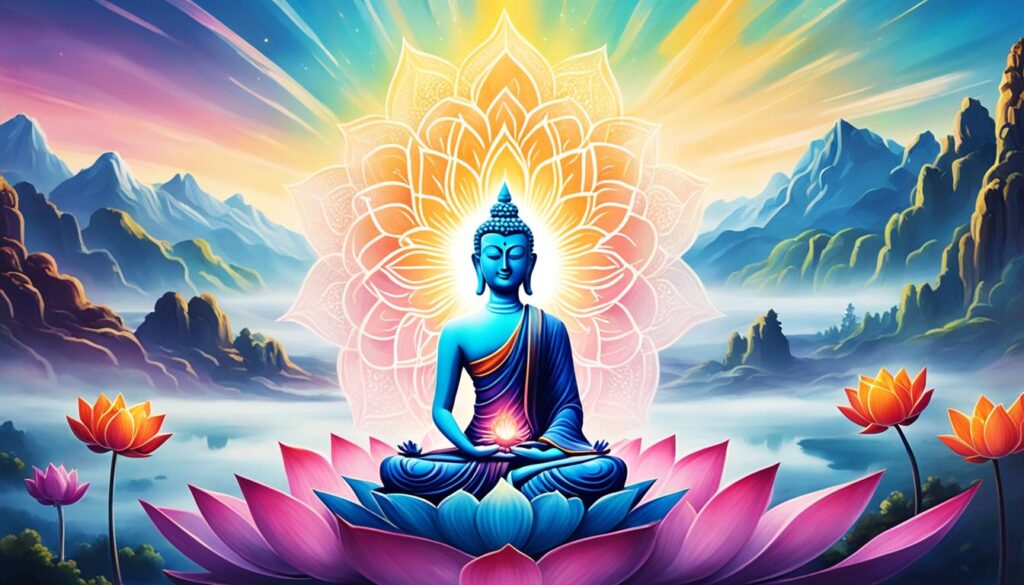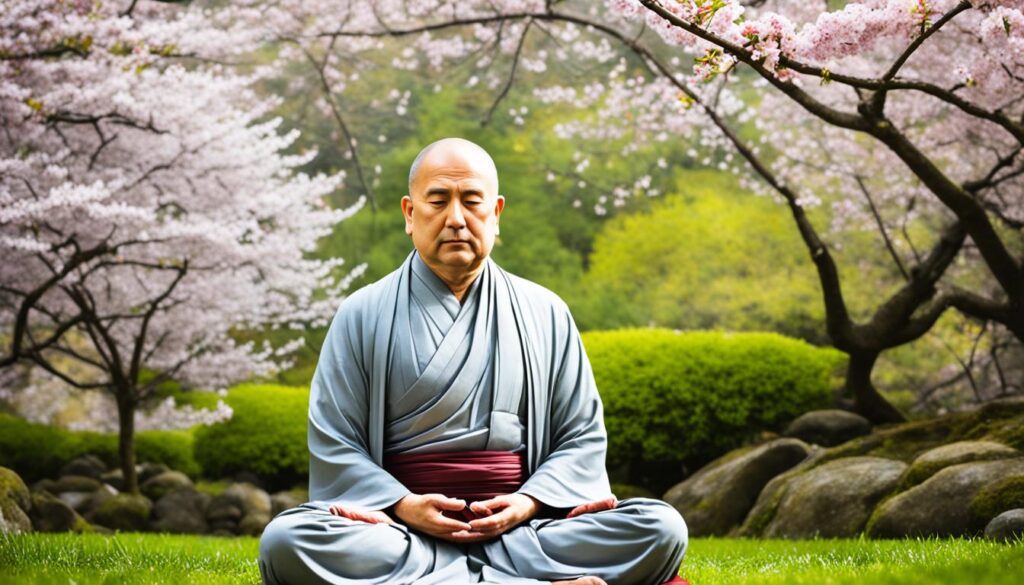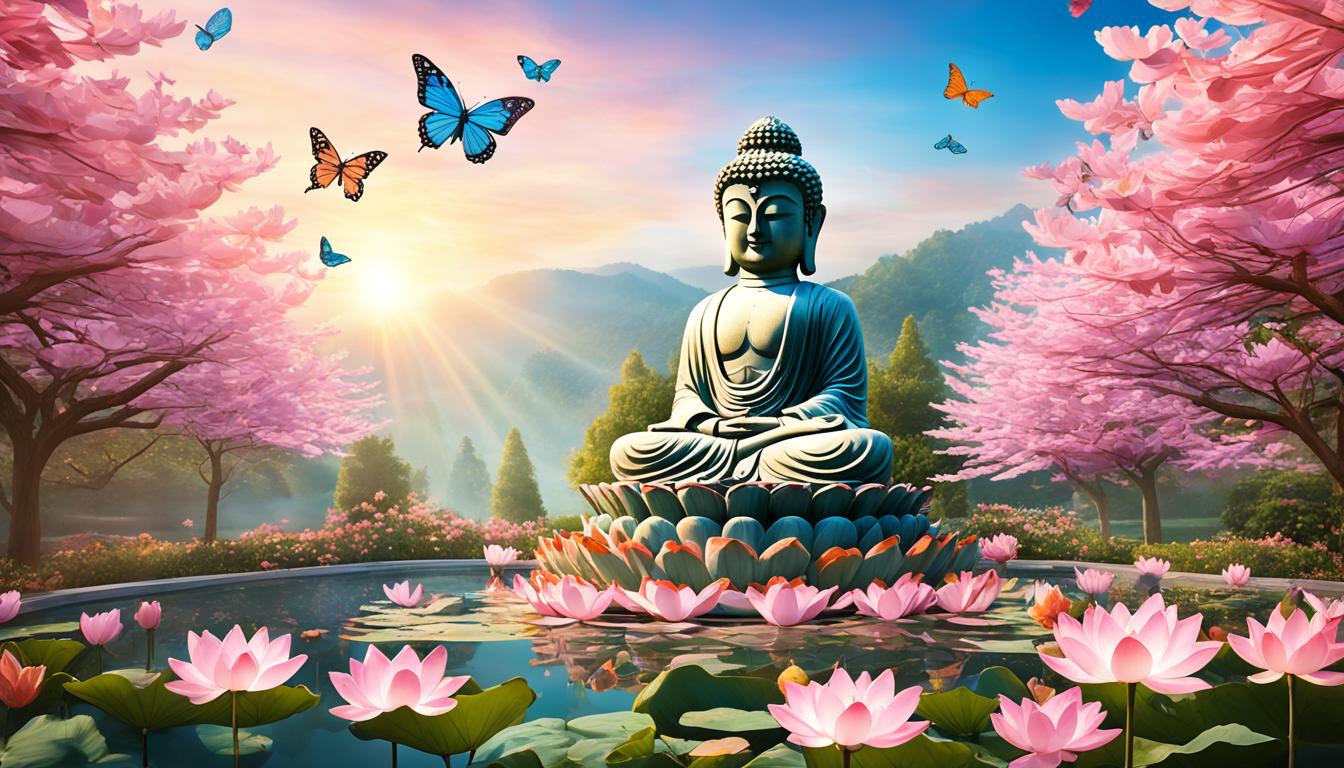Are you seeking a path to liberation and enlightenment that transcends individual abilities and social status? Look no further than Pure Land Buddhism, a tradition that centers around the power of Amida Buddha’s compassion to deliver beings from their negative karma. Through the practice of reciting the sacred phrase “Namo Amida Butsu,” Pure Land Buddhists aim to create a Pure Land of perfect bliss and attain enlightenment. But how exactly does this practice work, and what are the major tenets of Pure Land Buddhism? Let’s explore the heart of Pure Land Buddhism and discover how it can bring peace and liberation into your life.
Key Takeaways:
- Pure Land Buddhism centers around the practice of reciting the name of Amida Buddha to attain rebirth in the Pure Land and achieve enlightenment.
- The teachings of Pure Land Buddhism emphasize the power of Amida Buddha’s compassion and the interconnectedness of all beings.
- Key practices include reciting the name of Amida Buddha, visualizing the Pure Land, and cultivating gratitude and compassion towards others.
- Pure Land Buddhism has had a significant impact in East Asia, particularly in Japan, where it has become one of the most popular forms of Buddhism.
- The founders of Pure Land Buddhism, Honen and Shinran, played crucial roles in developing and popularizing the tradition in Japan.
The Essence of Pure Land Buddhism
In Pure Land Buddhism, the key beliefs revolve around the understanding that reciting the name of Amida Buddha with faith and devotion can lead to rebirth in the Pure Land and the attainment of enlightenment. This core practice is accessible to all individuals, regardless of their abilities or social status. The essence of Pure Land Buddhism lies in generating heartfelt gratitude towards Amida Buddha and living a life of compassion and mindfulness.
By reciting the name of Amida Buddha, practitioners seek to cultivate a deep connection with Amida’s boundless compassion and liberating vow. This practice allows individuals to transcend their ego-driven desires, liberate themselves from the cycle of suffering, and attain enlightenment.
Key Beliefs in Pure Land Buddhism
1. Rebirth in the Pure Land: Pure Land Buddhists believe that through sincere recitation of Amida Buddha’s name, they can be reborn in the Pure Land after death. The Pure Land is a realm of perfect bliss, free from the sufferings of this world.
2. Attainment of Enlightenment: The ultimate goal of Pure Land Buddhism is to attain enlightenment, the state of awakening and liberation from suffering. By being reborn in the Pure Land, practitioners can receive the guidance and teachings necessary to reach this enlightened state.
3. Accessibility and Inclusivity: Pure Land Buddhism emphasizes that the practice of reciting Amida Buddha’s name is accessible to all individuals, regardless of their intellectual abilities or social status. This inclusivity highlights the universal potential for liberation and enlightenment.
4. Gratitude and Compassion: Pure Land Buddhism emphasizes the importance of generating heartfelt gratitude towards Amida Buddha. Practitioners cultivate a profound sense of gratitude for Amida’s compassion in saving all beings from suffering. This gratitude extends to all beings, fostering a deep sense of compassion and the desire to alleviate the suffering of others.
By understanding these key beliefs in Pure Land Buddhism and embodying the practices of devotion, gratitude, compassion, and mindfulness, individuals can embark on a transformative spiritual journey towards liberation and enlightenment.

The Teachings of Amida Buddha
In Pure Land Buddhism, the teachings of Amida Buddha center around the power of compassion and the interconnectedness of all beings. Amida Buddha’s ultimate goal is to alleviate the suffering of all sentient beings and guide them towards enlightenment. To achieve this, Pure Land Buddhism emphasizes specific practices that deepen one’s connection with Amida Buddha and foster harmony within oneself and society.
Reciting the Name of Amida Buddha
One of the key teachings in Pure Land Buddhism is the practice of reciting the name of Amida Buddha. By reciting the sacred name, “Namo Amida Butsu,” with faith and devotion, practitioners seek to cultivate a deep connection with the compassionate qualities of Amida Buddha. This practice serves as a reminder of Amida Buddha’s vow to save all beings and encourages individuals to reflect on their own actions and aspirations.
Visualizing the Pure Land
In addition to reciting the name of Amida Buddha, Pure Land Buddhists engage in the practice of visualizing the Pure Land. The Pure Land is a realm of perfect bliss and enlightenment that Amida Buddha has created for those who entrust themselves to his compassion. Practitioners imagine this Pure Land as a place of beauty, serenity, and purity, where there is no suffering or delusion. This visualization helps to inspire and motivate individuals in their pursuit of liberation and enlightenment.
Cultivating Gratitude and Compassion
Central to the teachings of Amida Buddha is the cultivation of gratitude and compassion towards all beings. By recognizing and appreciating the compassion and grace of Amida Buddha, practitioners develop a sense of deep gratitude. This gratitude extends to all beings, leading to the cultivation of compassion and a genuine desire to alleviate the suffering of others. Pure Land Buddhism teaches that by embodying these qualities of gratitude and compassion, individuals contribute to the creation of a harmonious society.
Through these teachings and practices, Pure Land Buddhism provides a pathway for individuals to deepen their spiritual connection with Amida Buddha, foster inner peace, and contribute to the well-being of all beings. The emphasis on compassion, gratitude, and the interconnectedness of all beings resonates deeply with those seeking solace, enlightenment, and meaningful engagement in the modern world.

| Pure Land Buddhism Teachings | Pure Land Buddhism Practices | Pure Land Buddhism Principles |
|---|---|---|
| Compassion | Reciting the name of Amida Buddha | Interconnectedness of all beings |
| Gratitude | Visualizing the Pure Land | Cultivation of compassion |
| Enlightenment |
Pure Land Buddhism in East Asia and Beyond
Pure Land Buddhism has had a profound influence in East Asia, particularly in Japan, where it has emerged as one of the most revered forms of Buddhism. However, the significance of Pure Land teachings extends beyond Japan and can be found in other regions such as Tibet and Vietnam. The widespread practice of Pure Land Buddhism can be attributed to its accessibility and its emphasis on the transformative power of Amida Buddha’s compassion.
In East Asia, Pure Land Buddhism has become deeply ingrained in the cultural fabric, shaping the spiritual landscape and providing solace to millions. Its teachings offer a refuge from the challenges and struggles of daily life, guiding individuals on a path of liberation and enlightenment.
The significance of Pure Land Buddhism lies in its ability to offer a sense of hope and salvation, regardless of one’s background or social status. Its teachings resonate with people from all walks of life, uniting them in the pursuit of spiritual awakening.
As you delve deeper into the realm of Pure Land Buddhism, you begin to uncover the essence of its teachings and the immense impact it has had throughout East Asia and beyond.
| Region | Key Features |
|---|---|
| Japan | – Pure Land Buddhism thrives in Japan, with numerous temples dedicated to the practice. – Honen and Shinran, founders of Jodo Shinshu, have greatly influenced the development and popularity of Pure Land Buddhism in Japan. – The modern adaptation of Pure Land Buddhism in Japan emphasizes the importance of faith in Amida Buddha and gratefulness for the compassion received. |
| Tibet | – Pure Land teachings are integrated within the broader framework of Tibetan Buddhism. – The practice of Pure Land Buddhism in Tibet involves meditation, recitation of mantras, and visualization of the Pure Land. – The teachings emphasize compassion and the aspirations for rebirth in Sukhavati, the Pure Land of Amida Buddha. |
| Vietnam | – Influenced by its Chinese origins, Pure Land Buddhism in Vietnam centers around the recitation of Amida Buddha’s name. – The practice is deeply rooted in Vietnamese culture, appealing to devotees seeking spiritual solace and liberation. – Pure Land temples can be found throughout Vietnam, serving as sacred spaces for prayer and contemplation. |
Honen and the Development of Pure Land Buddhism
In the journey of Pure Land Buddhism, Honen emerged as a transformative figure in the Kamakura period, founding the Jodo (Pure Land) School of Buddhism. Through his teachings, Honen played a critical role in the popularization and evolution of Pure Land Buddhism in Japan.
At the heart of Honen’s teachings was the practice of reciting the name of Amida Buddha, known as the Nembutsu, as a means to attain rebirth in the Pure Land and achieve liberation from suffering. Honen believed that reciting the Nembutsu with pure faith and devotion could lead individuals of all backgrounds to enlightenment.
Honen’s teachings reverberated deeply within the society, resonating with people from all walks of life in the tumultuous times of the Kamakura period. His emphasis on the simplicity and accessibility of the Nembutsu practice made Pure Land Buddhism more inclusive and accessible to all, regardless of social status or education.
Following in the footsteps of his master, Shinran, one of Honen’s disciples, further developed and disseminated the teachings of Pure Land Buddhism. Shinran founded the Jodo Shinshu (True Pure Land) School, also known as Shin Buddhism, which continues to thrive today as one of the major branches of Buddhism in Japan.
Together, Honen and Shinran laid the foundation for the widespread practice of Pure Land Buddhism in Japan, bringing solace and hope to countless individuals seeking enlightenment and liberation from suffering.

| Key Figures | Contributions |
|---|---|
| Honen | Founder of the Jodo School of Buddhism |
| Shinran | Disciple of Honen; Founder of Jodo Shinshu |
Shinran and the Path of True Entrusting
Shinran, a disciple of Honen, played a pivotal role in deepening the teachings of Pure Land Buddhism. He emphasized the concept of true entrusting, known as Shinjin, which holds that liberation and enlightenment can be attained through complete reliance on the Other-Power of Amida Buddha’s compassion. Shinran’s teachings provide solace and guidance to followers seeking liberation amidst life’s challenges.
In contrast to other forms of Pure Land Buddhism, Shinran’s teachings center on the present moment and the realization of oneness with Amida Buddha’s vow of salvation. This distinguishes the Jodo Shinshu tradition, also known as Shin Buddhism, from other branches of Pure Land Buddhism. Shinran’s emphasis on the power of Amida Buddha’s compassion resonates deeply with practitioners who seek solace and guidance, guiding them on the path to enlightenment.
To better understand Shinran and his teachings, let’s delve into the main principles of Jodo Shinshu.
The Principles of Jodo Shinshu
- Shinjin: The core principle of Jodo Shinshu, Shinjin refers to the true entrusting in the Other-Power of Amida Buddha’s compassion. It involves recognizing one’s own spiritual limitations while fully relying on the power of Amida Buddha to attain liberation and enlightenment.
- Nembutsu: The practice of reciting the name of Amida Buddha, known as the Nembutsu, is central to Jodo Shinshu. This practice serves as a reminder of Amida Buddha’s infinite compassion and the vow to rescue all beings from suffering.
- Gratitude and Compassion: Jodo Shinshu recognizes the importance of cultivating gratitude towards Amida Buddha’s compassion and the interconnectedness of all beings. This leads to the development of compassion, both towards oneself and others, creating harmony and fostering spiritual growth.
Shinran’s teachings continue to inspire and guide practitioners of Jodo Shinshu in modern times. Through the path of true entrusting, individuals can find solace, liberation, and ultimate enlightenment.

| Key Concepts | Explanation |
|---|---|
| Shinjin | The concept of true entrusting in the Other-Power of Amida Buddha’s compassion. |
| Nembutsu | The practice of reciting the name of Amida Buddha as a reminder of his infinite compassion and vow to rescue all beings from suffering. |
| Gratitude and Compassion | The cultivation of gratitude towards Amida Buddha’s compassion and the development of compassion towards oneself and others. |
Pure Land Buddhism in Modern Times
Pure Land Buddhism continues to thrive and remain relevant in modern times, offering spiritual guidance and solace to individuals navigating the challenges of contemporary society. As the world becomes increasingly fast-paced and chaotic, the teachings of Pure Land Buddhism provide valuable insights for personal and societal harmony.
In the midst of our busy lives, the practice of mindfulness taught in Pure Land Buddhism allows us to cultivate a sense of presence and awareness. By directing our attention to the present moment and experiencing it fully, we can find peace and clarity in the midst of chaos. This mindfulness practice offers a powerful antidote to the distractions and anxieties that often consume our minds.
Moreover, Pure Land Buddhism emphasizes the cultivation of compassion, both towards ourselves and others. In a world rife with conflict and division, the teachings of Pure Land Buddhism invite us to genuinely connect with the suffering of all beings and respond with empathy and kindness. By developing a compassionate heart, we can foster understanding, harmony, and healing within our communities and beyond.
Many contemporary practitioners of Pure Land Buddhism continue to engage in the traditional practices that have been passed down through generations. Reciting the name of Amida Buddha, visualizing the Pure Land, and nurturing gratitude and compassion in daily life are ways in which individuals integrate the teachings of Pure Land Buddhism into their modern lifestyles.
Through the practice of reciting the name of Amida Buddha, practitioners seek to deepen their connection with Amida Buddha’s compassion. This practice serves as a constant reminder of the power of Amida Buddha’s vow to deliver all sentient beings from suffering and lead them to enlightenment.
Visualizing the Pure Land allows practitioners to experience a sense of tranquility and beauty that transcends the limitations of the physical world. It serves as an inspiration and motivation to strive for enlightenment and liberation from suffering.
Cultivating gratitude and compassion nurtures a positive and benevolent mindset in daily life. By extending compassion to ourselves and others, we contribute to a more harmonious and compassionate society.
Conclusion
Pure Land Buddhism offers a profound and accessible path to liberation and enlightenment. Through the power of Amida Buddha’s boundless compassion and the practice of reciting his sacred name, individuals can transcend the cycle of suffering and find true peace and harmony.
The main concepts of Pure Land Buddhism revolve around the interconnectedness of all beings and the cultivation of gratitude and compassion. By recognizing our shared humanity and embracing the teachings of this tradition, we can awaken to the inherent goodness within ourselves and manifest kindness towards others.
In today’s fast-paced and often chaotic world, the wisdom of Pure Land Buddhism remains relevant. Its emphasis on mindfulness and the nurturing of a compassionate heart offers invaluable guidance for navigating the challenges of modern life.
By immersing ourselves in the heart of Pure Land Buddhism, we open ourselves up to the transformative power of Amida Buddha’s love and develop the capacity to create a more harmonious and compassionate world. May we all find solace, liberation, and enlightenment on this sacred journey.
FAQ
What is Pure Land Buddhism?
Pure Land Buddhism is a Buddhist tradition that aims to remove the root cause of suffering, which is evil karma produced through selfish desires. It centers around the practice of reciting the sacred phrase, “Namo Amida Butsu,” to deliver beings from their negative karma and attain enlightenment.
What are the key beliefs in Pure Land Buddhism?
The core belief of Pure Land Buddhism is that by reciting the name of Amida Buddha with faith and devotion, one can be reborn in the Pure Land after death and attain enlightenment. This practice is accessible to all, regardless of individual abilities or social status. Pure Land Buddhism also emphasizes the importance of generating heartfelt gratitude towards Amida Buddha and living a life of compassion and mindfulness.
What are the teachings of Amida Buddha in Pure Land Buddhism?
The teachings of Amida Buddha emphasize the power of compassion and the interconnectedness of all beings. The practices of Pure Land Buddhism involve reciting the name of Amida Buddha, visualizing the Pure Land, and cultivating gratitude and compassion towards other beings. These practices aim to deepen one’s connection with Amida Buddha and create harmony within oneself and in society.
Where is Pure Land Buddhism practiced?
Pure Land Buddhism has had a significant impact in East Asia, particularly in Japan, where it has become one of the most popular forms of Buddhism. However, Pure Land teachings can also be found in other areas such as Tibet and Vietnam.
Who is Honen and what role did he play in the development of Pure Land Buddhism?
Honen, the founder of the Jodo (Pure Land) School of Buddhism, played a crucial role in the development and popularization of Pure Land Buddhism in Japan. He emphasized the practice of reciting the name of Amida Buddha as a means to attain rebirth in the Pure Land and achieve liberation from suffering.
What is the Jodo Shinshu tradition in Pure Land Buddhism?
The Jodo Shinshu (True Pure Land) School was founded by Shinran, a disciple of Honen. Shinran deepened the teachings of Pure Land Buddhism by emphasizing the concept of true entrusting, or Shinjin. He taught that it is through complete reliance on the Other-Power of Amida Buddha’s compassion that one can attain liberation and enlightenment.
Is Pure Land Buddhism relevant in modern times?
Yes, Pure Land Buddhism remains relevant in modern times, offering spiritual guidance and solace to individuals facing the challenges of contemporary society. The teachings of Pure Land Buddhism, such as mindfulness and compassion, provide insights for personal and societal harmony.
What are the main concepts of Pure Land Buddhism?
The main concepts of Pure Land Buddhism include the practice of reciting the name of Amida Buddha, the cultivation of gratitude and compassion, the belief in the power of Amida Buddha’s compassion to bring about liberation and enlightenment, and the interconnectedness of all beings.

